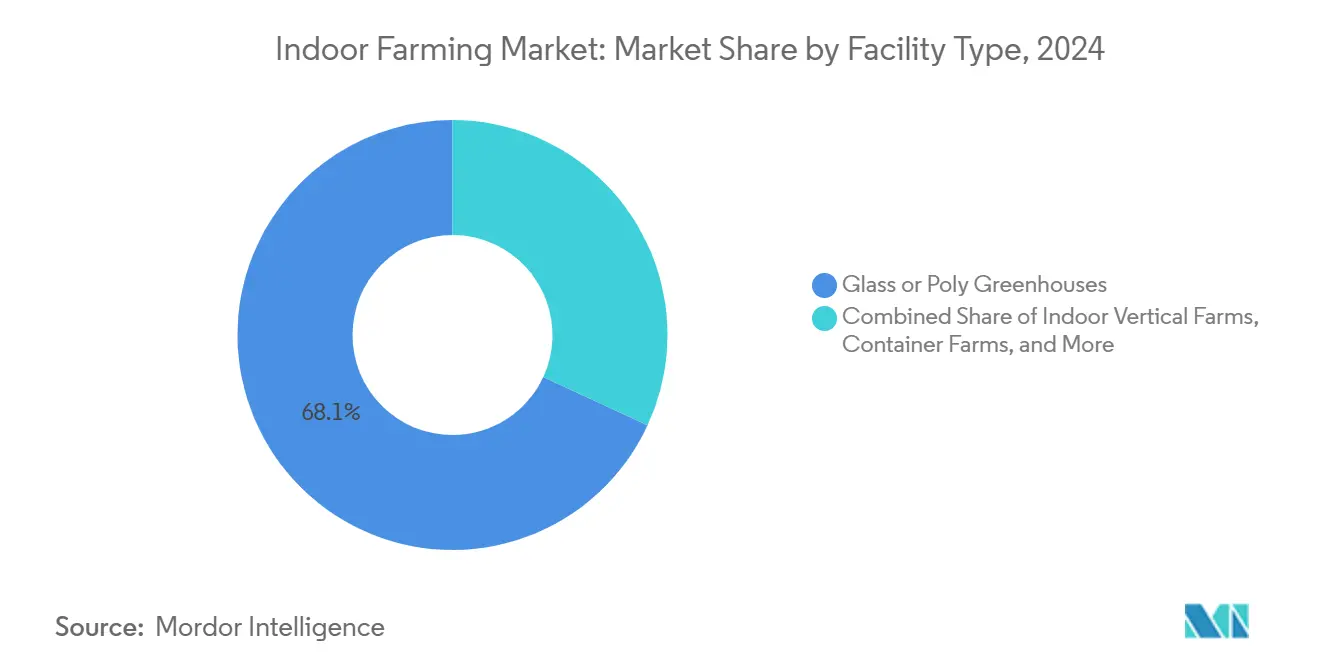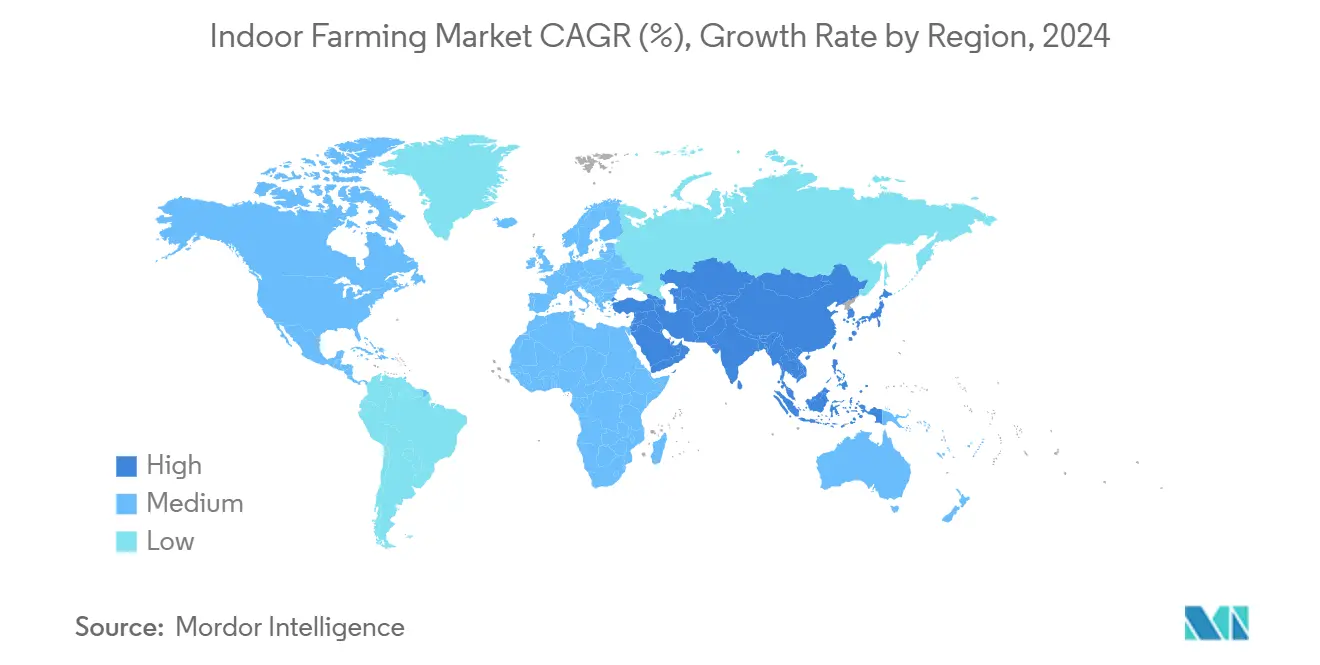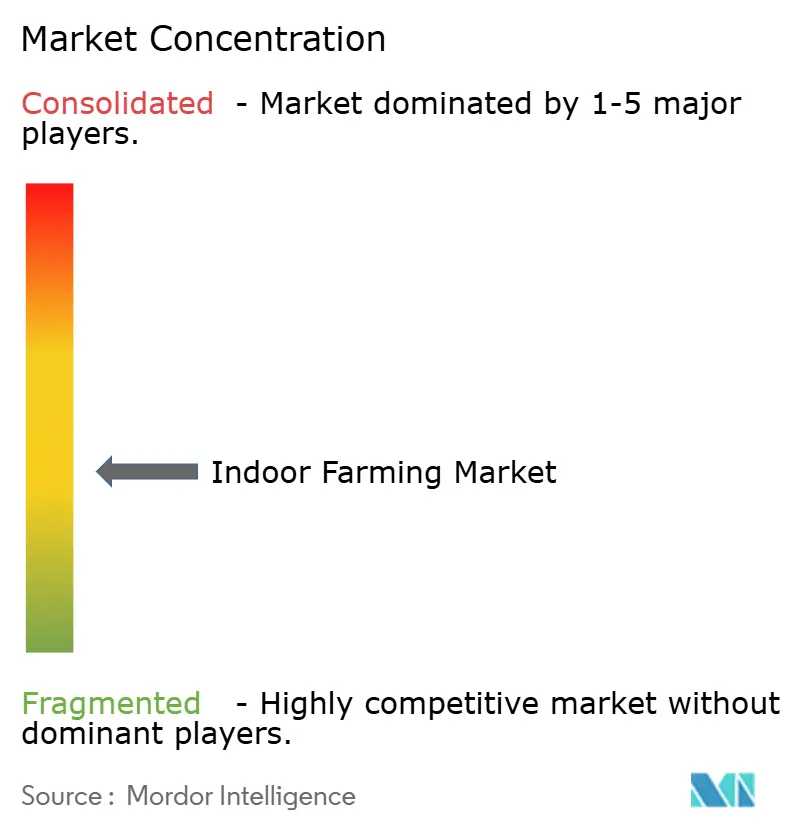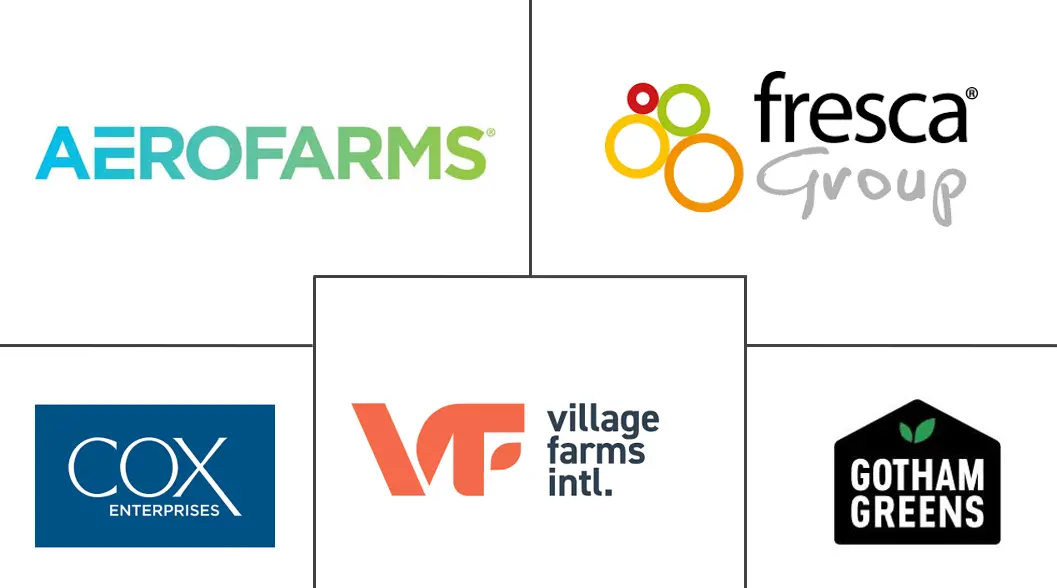Indoor Farming Market Size and Share

Indoor Farming Market Analysis by Mordor Intelligence
The indoor farming market size is estimated at USD 40.80 billion in 2025 and is projected to reach USD 77.18 billion by 2030, at a CAGR of 13.60% during the forecast period. Adoption is gaining momentum as cities search for resilient food systems and growers look for predictable yields that are insulated from weather shocks. Rapid improvements in LED efficacy have cut lighting energy use by up to 40% compared with high-pressure sodium fixtures. Artificial intelligence controls now trim overall facility energy consumption by another 25%, which pushes many projects into breakeven territory earlier in their lifecycles. Europe dominates the indoor farming market, largely due to its advanced expertise in greenhouse technology, particularly from the Netherlands. Meanwhile, the Asia-Pacific region is experiencing rapid growth in this sector, driven by increasing challenges related to land availability and the need for improved food security. Hydroponics remains the dominant growing method, yet aeroponics is scaling quickly because it delivers higher yields with less water, an attractive formula in drought-prone markets. Greenhouses still account for more than two-thirds of global installations, although multilevel vertical farms are proliferating where urban real-estate economics reward space efficiency.
Key Report Takeaways
- By growing system, hydroponics commanded a 58.3% share of the indoor farming market size in 2024, while aeroponics is forecast to accelerate at a 24.3% CAGR to 2030.
- By facility type, glass or poly greenhouses captured 68.1% revenue share in 2024, yet indoor vertical farms are set to expand at a 23.3% CAGR over the forecast horizon.
- By crop type, leafy greens accounted for a 41.5% share of the indoor farming market size in 2024, with strawberries advancing at an 18.1% CAGR as the fastest-growing crop category.
- By region, Europe led with 33.9% of the indoor farming market share in 2024, whereas Asia-Pacific is projected to post the highest 18.2% CAGR through 2030.
Global Indoor Farming Market Trends and Insights
Drivers Impact Analysis
| Driver | (~) % Impact on CAGR Forecast | Geographic Relevance | Impact Timeline |
|---|---|---|---|
| Urban demand for fresh, pesticide-free produce | +2.8% | Global, concentrated in North America and Europe | Medium term (2-4 years) |
| LED efficiency and HVAC (Heating, Ventilation, and Air Conditioning) cost declines | +3.2% | Global, early adoption in Netherlands and Japan | Short term (≤ 2 years) |
| Shrinking arable land and extreme weather volatility | +2.1% | Global, acute in Asia-Pacific and Middle East | Long term (≥ 4 years) |
| Surplus vacant retail/warehouse real estate repurposed | +1.9% | North America and Europe, urban centers | Medium term (2-4 years) |
| Carbon-credit monetization for low-footprint produce | +1.4% | Europe and North America, regulatory markets | Long term (≥ 4 years) |
| Corporate Scope-3 targets driving long-term off-take contracts | +2.2% | Global, multinational corporations | Medium term (2-4 years) |
| Source: Mordor Intelligence | |||
Urban Demand for Fresh, Pesticide-Free Produce
Consumers living in dense cities are gravitating toward produce grown in controlled environments where contamination risks are virtually eliminated and “picked today, sold tomorrow” freshness is achievable. Controlled-environment farms meet these expectations by fine-tuning nutrients, humidity, and airflow, leading to consistent taste and visual appeal that command premium pricing. The COVID-19 pandemic reinforced demand for traceable food systems, persuading supermarket executives to dedicate more shelf space to locally grown indoor crops. Governments are responding as well. The United Arab Emirates’ “Plant the Emirates” program targets a 20% jump in domestically controlled-environment output within five years. Collectively, these shifts underpin the steady expansion of the indoor farming market in core consumption hubs.
LED Efficiency and HVAC (Heating, Ventilation, and Air Conditioning) Cost Declines
Breakthroughs in photonics and thermal management technology are redefining unit economics. Field trials by Grodan and Signify validated a 40% cut in heating requirements while preserving premium tomato yields [1]Source: Cristina Valente, “LED Lighting Trials Slash Heat Input for Tomatoes,” agritechtomorrow.com. Modern fixtures now incorporate spectral tuning that enhances crop morphology and boosts nutrient density. Machine-learning HVAC (Heating, Ventilation, and Air Conditioning) systems predict optimal setpoints based on external weather and plant growth phase, dropping total energy needs by a further 15%. Utility rebate programs plus participation in demand-response markets allow operators to shift load away from peak-price periods and monetize unused capacity. Renewable integration is accelerating. Latvian demonstration sites have reached positive cash flow using roof-mounted photovoltaics that cover 30% of annual demand. Lower operating costs translate directly into wider adoption and deeper penetration of the indoor farming market.
Shrinking Arable Land and Extreme Weather Volatility
Climate-induced drought, flooding, and soil degradation are cutting usable farmland and pushing crop insurance premiums higher. Controlled-environment facilities answer these challenges by decoupling production from external conditions and delivering up to 90 strawberry plants per square meter versus 10–12 in conventional greenhouses. The UAE, which imports 90% of its food, has proved the concept by scaling protected agriculture platforms that use 95% less water than open-field cultivation. In Saudi Arabia, pilot projects are demonstrating high-yield strawberry production in desert climates through root-zone temperature optimization. Food processors prize this consistency and are willing to sign multi-year supply contracts, fuelling long run growth of the indoor farming market.
Corporate Scope-3 Targets Driving Long-Term Off-Take Contracts
Large manufacturers and food service providers are revisiting procurement strategies to hit greenhouse-gas targets. Cargill’s partnership with ENOUGH and Nestlé Purina on sustainable protein sourcing illustrates the shift toward low-footprint inputs. In 2024, Emirates Flight Catering’s complete takeover of Bustanica places a 1 million kg annual lettuce supply squarely inside the airline’s catering arm, tightening control over emissions and food safety. Such long-term contracts anchor revenue visibility and strengthen investor confidence, sustaining momentum in the indoor farming market.
Restraints Impact Analysis
| Restraint | (~) % Impact on CAGR Forecast | Geographic Relevance | Impact Timeline |
|---|---|---|---|
| High CAPEX and energy intensity | -4.1% | Global, acute in high energy cost regions | Short term (≤ 2 years) |
| Scarcity of skilled horticultural workforce | -2.3% | North America and Europe, urban markets | Medium term (2-4 years) |
| Venture Capital funding pull-back after high-profile bankruptcies | -3.7% | Global, concentrated in venture markets | Short term (≤ 2 years) |
| Urban grid-congestion and power-availability limits | -1.8% | Asia-Pacific urban centers, aging infrastructure | Long term (≥ 4 years) |
| Source: Mordor Intelligence | |||
High CAPEX and Energy Intensity
Building a multilevel farm with sophisticated lighting, irrigation, and automation often costs multiples of a conventional greenhouse, and electricity can represent 40% of ongoing expenses. Operators cultivating highlight crops such as cannabis are migrating from high-pressure sodium lamps to LEDs that cut consumption by more than 40%, yet upfront fixture costs remain material. Demand-response participation partially offsets power bills but requires advanced scheduling software and resilient crop plans. In markets with high tariff volatility, renewable power purchase agreements, and behind-the-meter batteries are becoming standard risk-mitigation tools.
Venture Capital Funding Pull-Back After High-Profile Bankruptcies
Investor enthusiasm cooled sharply after Bowery and AeroFarms shuttered operations despite raising more than USD 700 million each, leading to a 90% decline in global vertical-farming funding during 2023. Container-farm pioneer Freight Farms entered Chapter 7, leaving customers without replacement parts or software updates and highlighting ecosystem fragility. Capital now flows primarily to operators with audited financials, positive unit economics, and clear paths to profit. The result is slower project starts but healthier balance sheets, a trend likely to stabilize the indoor farming industry over the medium term. Partnerships with strategic food companies are substituting for venture backing, blending financial strength with market access.
Segment Analysis
By Growing System: Hydroponics Dominance Faces Aeroponics Challenge
Hydroponics retained a 58.3% share of the indoor farming market in 2024 because of its proven scalability, extensive supplier network, and moderate technical complexity. Many mature greenhouse operators use computerized nutrient-film systems that deliver predictable yields for high-volume leafy greens. Aeroponics is advancing at a 24.3% CAGR as growers focus on water savings and faster root oxygenation, attributes that are critical when cultivating premium strawberries or vine crops prone to root diseases. Aquaponics occupies a smaller niche but is attracting sustainability-minded municipalities, creating circular-economy models that co-locate fish and vegetable production. AI-driven sensor suites now optimize dissolved oxygen and nutrient dosing, cutting waste across all systems and trimming electricity bills by 25% in large hydroponic setups [2]Source: Natalie Grobe, “AI-Powered Climate Control Cuts Energy Use in Greenhouses,” news.cornell.edu.
The choice between systems increasingly reflects crop economics rather than technical preference. Leafy greens require shallow root zones and quick turnover that align with nutrient-film methods. High-margin berries justify aeroponic complexity because increased airflow delivers superior fruit firmness and color that command premiums. Operators often blend techniques, reserving deep-water culture beds for long-cycle tomatoes while dedicating stacked aeroponic towers to herbs demanding exacting flavor profiles. Such hybrid strategies help maximize the indoor farming market size per facility by tailoring conditions to each crop’s physiology.

Note: Segment shares of all individual segments available upon report purchase
By Crop Type: Leafy Greens Dominance Challenged by Strawberry Innovation
Leafy greens held 41.5% of 2024 revenue due to 30- to 45-day growth cycles, consistent demand, and compatibility with low-bed hydroponic lines. Retailers value the predictable shelf life and reduced pathogen risk compared with open-field products. Strawberries are growing at an 18.1% CAGR because controlled environments eliminate seasonality and lift yields beyond traditional greenhouse benchmarks. In 2024, Plenty’s Chesterfield campus plans to ship 4 million lb annually from under 40,000 ft², highlighting unprecedented space efficiency. Tomatoes and peppers require longer cycles but deliver stable cash flow to institutional buyers, while microgreens and herbs feed high-margin restaurant channels.
Diversification strategy is critical. Operators staggering lettuce rotations with high-value herbs can smooth revenue and deploy facility resources throughout the day. Academic trials show that optimal calcium levels paired with 200 micromoles per square meter per second of photon flux lift strawberry yields by 42.3% under indoor conditions. Ornamental plants and cut flowers are emerging as another avenue to unlock new revenue without retooling core infrastructure. Diversified crop plans, therefore, help operators capture a larger indoor farming market share while buffering commodity price swings.
By Facility Type: Greenhouses Lead While Vertical Farms Gain Momentum
Glass or poly greenhouses captured 68.1% of installations in 2024, benefiting from partial reliance on free solar radiation and decades of engineering refinement. Their modular construction lowers capex per square foot and supports crops with substantial height, such as vine tomatoes and cucumbers. Indoor vertical farms are expanding at a 23.3% CAGR as urban landlords repurpose vacant warehouses, slashing last-mile logistics and reducing spoilage. In 2024, the planned Dubai GigaFarm will span 83,612 m² and output 3 million kg of produce annually while trimming water use by 98%, illustrating why capital continues to flow into stacked-shelf architectures. Container farms serve military bases and island nations where land is at a premium and supply chains are vulnerable.
Greenhouse innovation now includes dynamic glass coatings that vary light transmission, reducing evaporative load and maintaining optimal photosynthetically active radiation. Conversely, vertical-farm developers focus on heat-recovery chillers and phase-change storage to shave peak electricity draw. Energy management software orchestrates both light cycles and HVAC (Heating, Ventilation, and Air Conditioning), producing 25% energy savings in next-generation facilities. Consequently, each model secures a distinct value proposition inside the indoor farming market, greenhouses for bulk commodity volumes and vertical farms for hyper-local premium categories.

Note: Segment shares of all individual segments available upon report purchase
Geography Analysis
Europe boasts a 33.9% portion of global spending, anchored by the Netherlands’ cluster of high-tech greenhouses, a workforce skilled in climate control, and carbon-tax incentives that speed the adoption of low-emission agriculture. German and Spanish retailers, meanwhile, broaden sourcing contracts to include mid-sized vertical farms that shorten truck routes and ensure year-round inventory. Energy-price volatility is a hurdle, but widespread district-heating networks and the growing availability of renewable power purchase agreements counterbalance cost risk.
Asia-Pacific records the fastest 18.2% CAGR, propelled by land constraints and a sizeable urban middle class seeking safe, traceable produce. Singapore’s government offers grants and floor-area concessions for rooftop farms, although several high-profile closures reveal the difficulty of matching capital intensity with local demand [3]Source: Kelly Lim, “Singapore Vertical Farm Closures Highlight Operating Challenges,” channelnewsasia.com. China’s coastal provinces are establishing controlled-environment hubs within new “agri-tech parks” that pair universities with venture investors, accelerating best-practice diffusion. In Japan, municipal utilities subsidize LED deployment to stabilize night-time grid load, indirectly lowering production costs.
North America, while mature, continues to add large greenhouse acreage. BrightFarms’ 1.5 million square feet Texas complex features evaporative cooling that keeps summer leaf temperatures below 77 degrees Fahrenheit, enabling year-round supply contracts with regional grocers. Mexico is scaling shade-house vegetables for export into border states, leveraging favorable sunlight and labor cost advantages. The Middle East invests aggressively in sovereign funds back vertical projects that promise food-security dividends and reduced desalination demand. Africa exhibits early-stage adoption, most notably in Kenya and South Africa, where solar-powered container farms mitigate unreliable grid supply. Collectively, these dynamics confirm that the indoor farming market expands fastest wherever public policy, energy prices, and urban demand align.

Competitive Landscape
Competition remains moderately fragmented, yet consolidation pressures are intensifying after several heavily funded entrants failed to reach profitability. The five largest operators together captured around 25% of the indoor farming market share in 2024. Region-specific greenhouse growers dominate commodity categories, while technology-led vertical farm specialists concentrate on premium produce. In 2024, Local Bounti has pivoted from aggressive acreage expansion to refining its Stack and Flow platform, achieving 30 times higher productivity per acre than outdoor systems and securing multi-year retail contracts that lock in demand. AI-powered climate control is now the decisive differentiator, enabling consistent quality and lowering labor dependence in an environment where skilled horticulturists are scarce.
Achieving operational efficiency has become the new benchmark of excellence. Leaders have embedded real-time cost dashboards that track kilowatt-hours per kilogram and grams of fertilizer per plant, metrics that drive continuous improvement programs. Successful players are concurrently integrating renewable energy assets or signing indexed power agreements to stabilize costs. Strategic partnerships are multiplying. Emirates Flight Catering’s full purchase of Bustanica ensures a captive supply for in-flight catering while showcasing a template for vertical integration.
White-space opportunities persist in high-margin berry varieties and cold-chain-challenged regions where conventional logistics underperform. Modularity is also gaining traction with firms offering pre-assembled grow modules that can deploy capital two times faster than bespoke-build competitors, an attractive proposition for retailers converting vacant hypermarkets. As investors view scale alone as insufficient, the market is tilting toward operators capable of demonstrating sustained EBITDA margins and clear technology moats. These shifts collectively reshape the indoor farming market toward stable, efficiency-driven growth.
Indoor Farming Industry Leaders
AeroFarms
Village Farms International Inc.
Gotham Greens
Fresca Group (Thanet Earth)
COX Enterprises, Inc (BrightFarms)
- *Disclaimer: Major Players sorted in no particular order

Recent Industry Developments
- December 2024: Local Bounti Corporation entered a two-year contract to supply living butter lettuce to 13 distribution centers of a multinational retailer. This agreement is expected to enhance the company's distribution network and strengthen its presence in the market by ensuring a steady supply of fresh produce to a wider customer base.
- December 2024: BrightFarms opened a 1.5 million ft² greenhouse in Texas equipped with advanced cooling systems, enabling year-round production of fresh produce and meeting growing consumer demand for locally sourced vegetables.
- February 2024: Emirates Flight Catering has completed the acquisition of Bustanica, securing full ownership of the world’s largest indoor vertical farm. This acquisition aligns with the company’s strategy to enhance its sustainable food production capabilities and reduce its environmental footprint.
Research Methodology Framework and Report Scope
Market Definitions and Key Coverage
Our study defines the indoor farming market as the value of crops grown entirely inside purpose-built, fully enclosed facilities where light, temperature, humidity, and nutrients are actively managed, including glass or poly greenhouses, multi-tier vertical farms, container units, and indoor deep-water culture systems. Hydroponic, aeroponic, aquaponic, soil-based, and hybrid production methods are covered at farm-gate prices.
Scope exclusion: open-field, high-tunnel, or shade-house cultivation and any livestock operations are outside the study.
Segmentation Overview
- By Growing System
- Aeroponics
- Hydroponics
- Aquaponics
- Soil-based
- Hybrid
- By Facility Type
- Glass or Poly Greenhouses
- Indoor Vertical Farms
- Container Farms
- Indoor Deep-Water Culture Systems
- Other Facility Types
- By Crop Type
- Fruits and Vegetables
- Leafy Vegetables
- Tomato
- Strawberry
- Eggplant
- Other Fruits and Vegetables
- Herbs and Microgreens
- Basil
- Tarragon
- Wheatgrass
- Other Herbs and Microgreens
- Flowers and Ornamentals
- Perennials
- Annuals
- Ornamentals
- Other Flowers and Ornamentals
- Other Crop Types
- Fruits and Vegetables
- By Geography
- North America
- United States
- Canada
- Mexico
- Rest of North America
- Europe
- Germany
- United Kingdom
- France
- Spain
- Italy
- Russia
- Rest of Europe
- Asia-Pacific
- China
- Japan
- India
- Australia
- Singapore
- South Korea
- Rest of Asia-Pacific
- Middle East
- Saudi Arabia
- United Arab Emirates
- Turkey
- Rest of Middle East
- Africa
- South Africa
- Kenya
- Nigeria
- Rest of Africa
- North America
Detailed Research Methodology and Data Validation
Primary Research
We spoke with commercial growers, controlled-environment engineers, LED manufacturers, nutrient-solution formulators, and fresh-produce distributors across North America, Europe, and Asia-Pacific. Their input on realistic yield ceilings, typical ex-farm selling prices, and planned capacity helped us reconcile secondary patterns and stress-test assumptive ranges.
Desk Research
Mordor analysts gathered baseline figures from tier-one public sources such as FAO FAOSTAT, USDA NASS, Eurostat crop spatial data, and World Bank urbanization series, then cross-checked them with customs codes for greenhouse produce. Patents accessed through Questel, electricity-tariff tables from the IEA, and trade-association releases (e.g., Association for Vertical Farming) refined technology adoption curves. Company 10-Ks, investor decks, and funding databases on D&B Hoovers, plus news hits on Dow Jones Factiva, filled recent volume and price gaps. The sources cited illustrate breadth; many additional references informed validation and context.
Market-Sizing & Forecasting
A top-down reconstruction begins with region-level controlled-environment acreage, multiplies it by crop-specific yield factors, and applies weighted average selling prices, producing a baseline value. Selective bottom-up checks, such as sampled LED shipment audits, greenhouse acreage rolls, and container-farm unit counts, validate and fine-tune totals. Key model drivers include LED cost trajectories, urban fresh-produce demand growth, electricity tariffs, greenhouse capacity additions, and per capita salad consumption. Multivariate regression, backed by scenario analysis for sharp energy swings, extends the view through the forecast period.
Data Validation & Update Cycle
Outputs undergo peer review, anomaly flags trigger re-contact with sources, and large variances are re-modeled before sign-off. Reports refresh each year, with interim updates when policy shifts or major investments materially change the baseline.
Why our Indoor Farming Baseline earns trust
Published estimates seldom align because providers vary scope, pricing assumptions, and refresh cadence.
Differences widen when some focus on technology spend while others bundle every crop revenue stream.
Benchmark comparison
| Market Size | Anonymized source | Primary gap driver |
|---|---|---|
| USD 40.80 bn (2025) | Mordor Intelligence | - |
| USD 42.08 bn (2024) | Regional Consultancy A | Adds equipment sales to crop revenue, inflating base |
| USD 20.30 bn (2023) | Global Consultancy B | Limits scope to technology outlay, omits produce value |
| USD 22.30 bn (2024) | Industry Analyst C | Excludes glass greenhouses, relies on small Asia sample |
The comparison shows that our disciplined scope selection, blended model logic, and annual refresh provide decision-makers with the most balanced, transparent baseline available.
Key Questions Answered in the Report
How large is the indoor farming market in 2025?
The indoor farming market stands at USD 40.8 billion in 2025 and is set to reach USD 77.18 billion by 2030.
Which region is growing quickest in indoor farming?
Asia-Pacific shows the fastest growth with an 18.2% CAGR through 2030, driven by land scarcity and food security initiatives.
What technology trends are lowering operating costs?
Advances in high-efficacy LEDs and AI-driven HVAC controls are cutting lighting and climate-conditioning energy consumption by up to 40%.
Why are strawberries attracting investment?
Strawberries deliver premium pricing and have achieved yield gains above 40% in controlled environments, supporting an 18.10% CAGR.



